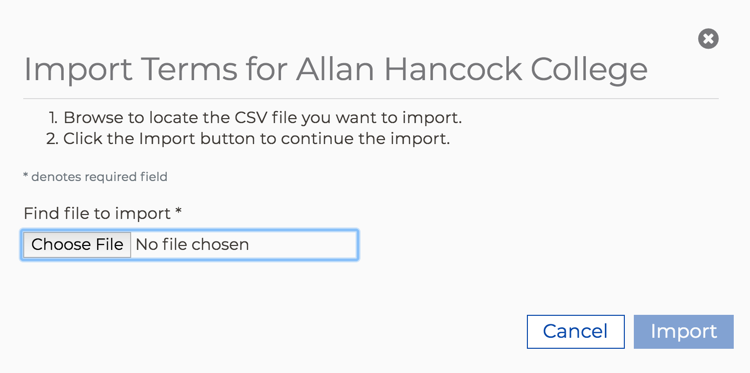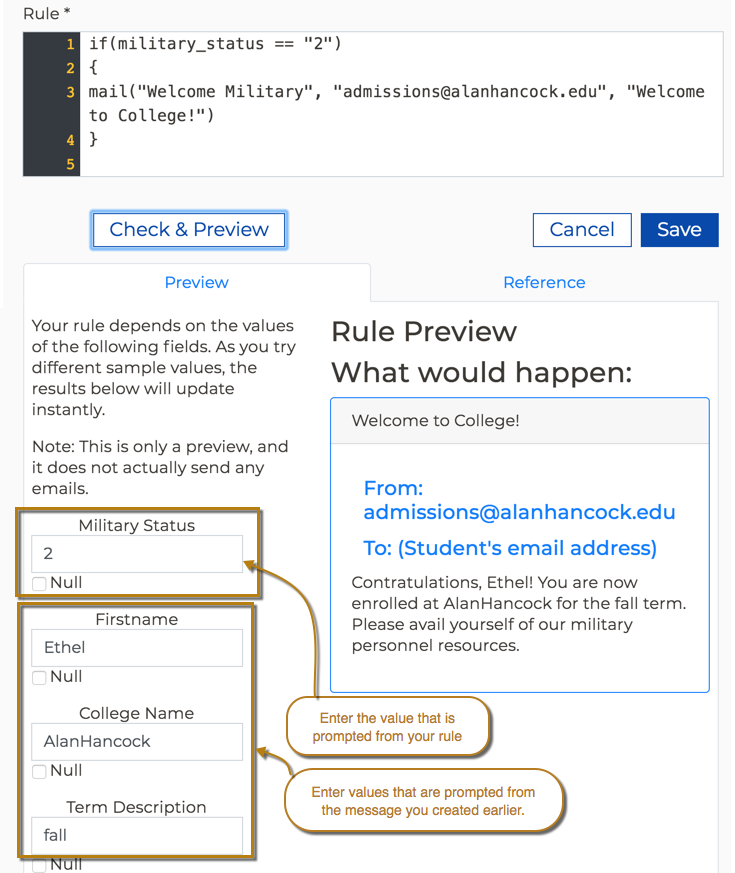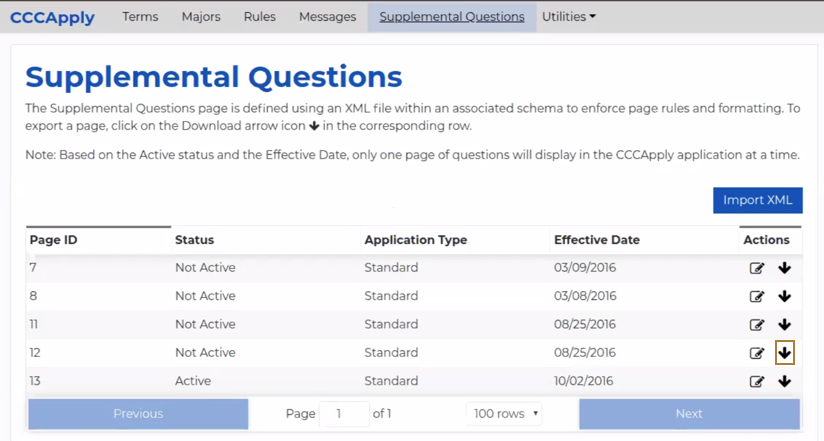| Panel | ||||||
|---|---|---|---|---|---|---|
| ||||||
The CCCApply Administrator User Guide can be exported to PDF or Word by selecting the “Export” option in the More Actions menu in the upper right of this page. |
...
| Note |
|---|
Getting to the new CCCApply Administrator requires staff users to sign in to the CCC Administrator using their college-specific URL. Click here to find Administrator URLs or contact College Support Services at staffsupportccctc@openccc.zendesk.com |
...
System Administrator
(Applications->System Administrator)
The System Administrator module provides:
SSO-based authentication to all CCC colleges through custom college-specific URLs configured to their college or district IdP
User management for all authorized CCC college staff and faculty users
Access management to all integrated CCCTC administrator applications and services through a single point-of-entry
User Manager
(Applications->System Administrator->User Manager)
The User Manager module allows authorized users to view, add, edit, and delete* users within the scope of their own authorized user permissions. The User Manager section provides the ability for users with authorized role(s) to create new users and permissions for your college or district.
...
Launching the CCCApply Administrator
(Applications->CCCApply Administrator)
If your credentials include permission to configure the CCCApply Standard application, CCCApply International application, and/or CC Promise Grant (BOG Application) for your college or district, you can access those via the CCCApply Administrator.
...
Have ready an edited .csv file of terms for importing. See Editing the Exported Terms CSV File for details.
From the Terms Summary table, click Import Terms to display…
...the Import Terms dialog box:Click Choose File to display your computer’s file navigator.
Navigate and select the terms .csv file you want to import. The file name for the file you selected displays next to the Choose File button.
Click Import to import the terms .csv file, close the Import Terms dialog box, and display the Terms Summary table where all rows are replaced/updated and the terms list refreshes to match your imported values.
...
...
| Panel | ||||||
|---|---|---|---|---|---|---|
| ||||||
Important: The Noncredit Application requires configuration of the Majors module. |
...
| Panel | ||||||
|---|---|---|---|---|---|---|
| ||||||
Majors are stored and managed in the Majors table in the CCCApply Administrator. All active majors will appear to end-users (students) in the appropriate CCCApply application as long as the current date is between the major’s configured Major Start Date and Major End Date. |
Majors Table
The table below provides details for populating each field and attribute in the Majors table. The row order below follows the single Add Major screen.
...
Name
...
Best Practice
...
Major Description
Enter your college’s description for a particular major, in 100 characters or less.
| Note |
|---|
The text you enter here displays in the Intended Major or Program of Study drop-down list that appears on the Enrollment Information tab of the CCCApply or International application(s). The majors display in alphabetical order regardless of the order you add or import your majors in the CCCApply Administrator. |
...
Major Code
Enter your unique college code for the major, up to 30 characters.
DO NOT EDIT AN EXISTING MAJOR CODE
| Warning |
|---|
The Major Code cannot be edited once it is added or imported to the major table and saved as a record. |
...
Major Start Date
...
Enter the date when this major will start being available for selection by an applicant in either the CCCApply or International application(s)’ Intended Major or Program of Study drop-down list.
...
Major End Date
...
Enter the date in which this major will no longer be available for selection by an applicant in either the CCCApply or International application(s)’ Intended Major or Program of Study drop-down list. For a major to appear in the application’s drop-down list, the current date must be between ‘major:date_start’ and ‘major: date_end’ (inclusive).
If you do not want to end-date your major, you must select the Major has no end date check box.
...
Major has no end date
check box
...
Select this check box if the major will have no end date. When this check box is selected, the Major End Date field becomes hidden.
...
TOP Code
OPTIONAL field.
If used, enter the major’s six-character Taxonomy of Programs (TOP) code from the CCCCO (Chancellor’s Office).
| Note |
|---|
The TOP Code is NOT a required field and is not delivered with submitted applications. |
...
Program Control #
OPTIONAL field.
If used, enter the CCCCO Program Control Number code for each major from the Chancellor’s office.
| Note |
|---|
The Program Control # is NOT a required field and is not delivered with submitted applications. |
...
Application Type
...
REQUIRED field. This value must be selected, else the major will default to the CCCApply Standard application.
Select the Application Type from the drop-down for which you are configuring majors.
...
Categories
OPTIONAL field.
Major categories may be added, edited or removed by the college to filter or group your list of majors. Major categories are defined by each college.
You may create multiple category values (pressing Enter after each entry) which can be associated with multiple majors. There is no limit to the number of categories you can add.
Each Categories value has a limit of 100 characters.
Click the “x” icon to remove a category from the Add Major screen.
When adding categories manually using the Add Major screen, you must hit ENTER after each correctly spelled category.
If used, the creation of one category will enable the Major Category Filter and display the Category drop down menu in the application.
If used, the applicant is required to select a category first, then select a major.
| Note |
|---|
When you configure the Categories field for a major, students will be required to select a Major Category in the application. |
| Warning |
|---|
Important: If you implement the Major Category Filter you must associate each major to at least one category. |
See Configuring Major Categories below for further details.
...
CIP Code
...
OPTIONAL field.
If you choose to populate the CIP Code field, enter the Classification of Instructional Programs (CIP) code.
...
Award Type
REQUIRED when implementing the Ed Goal / Majors Filter for Associate Degrees.
Select the Award Type option that best aligns to each major.
REQUIRED for importing the Majors CSV file.
The <awardType> column values must not contain any spaces and MUST be one of the following allowed values:
AA_T
AS_T
AA_degree
AS_degree
BA_degree
BS_degree
Certificate
Other
None
| Note |
|---|
If you do not have an award type aligned for a major, please enter “None". |
...
current date is between the major’s configured Major Start Date and Major End Date. |
Editing a Major
Use the following steps to edit a major:
Select the Edit icon on the row for the major that you want to edit. This will display the Edit Major dialog box.
Make your edits and click Save to close the Edit Major dialog box and return focus to the Majors table.
Archiving a Major
Archiving majors in the CCCApply Administrator renders them inaccessible and should be thought of as the same as deleting them. Archive functionality will be extended to be fully functional in a future release.
...
Ensure that you adhere to the following rules when you edit and populate your Majors CSV file.
Reminder: The Majors for the International Application requires its own unique and a separate majors CSV file. The same file format and rules apply for the International Application (differences are specified where applicable).
Guide for using the Add/Edit Major Screen (single major) | Guide for Configuring the Majors CSV File | ||||||||||
|---|---|---|---|---|---|---|---|---|---|---|---|
Name | Required? | Major Field Configuration Notes | CSV Column Heading | Required? | Important CSV File Configuration Notes | ||||||
Header Row | Yes. | The header row pertains to the Majors CSV file only. Required for the CSV file | Header Row | YES | IMPORTANT: The file header row containing the column headings is required for your .csv file to import successfully and for the values to be stored correctly in the admin system.
| ||||||
Application | Yes | System-generated based on which CCCApply application you are exporting from in the Administrator. For the CCCApply Standard & Noncredit applications, export your majors file from the CCCApply application in the Administrator. For the CCCApply International application, export and import your majors CSV file from the International application in the Administrator. | application | YES |
| ||||||
Major Code | Yes | Enter your unique college code for each major, up to 30 characters. DO NOT EDIT AN EXISTING MAJOR CODE
| code | YES |
| ||||||
Major Description | Yes | Enter the name or description for a particular major in 100 characters or less. The major description is the name or title of the major which displays alphabetically to the end-user in the application.
| description | YES |
| ||||||
Major Category | No | OPTIONAL field.
| category | NO |
If your college has opted to implement Major Categories, then…
| ||||||
TOP Code | No |
| topCode | NO |
| ||||||
Program Control Number | No | OPTIONAL field. If used, enter the CCCCO Program Control Number code for each major from the Chancellor’s office. | programControlNumber | NO |
| ||||||
Award Type | Yes | REQUIRED if implementing the Ed Goal / Majors Filter for Associate Degrees. On the Add/Edit Major screen:
| awardType | YES* |
| ||||||
Application Type | Yes |
| applicationType | YES |
| ||||||
CIP Code | No | OPTIONAL field. If you choose to populate the CIP Code field, enter the Classification of Instructional Programs (CIP) code. | cipCode | NO |
| ||||||
EduGoals | No | NOT APPLICABLE. Currently not part of the Ed Goal/Majors Filter. | eduGoals | NO | Leave this column in place and LEAVE IT EMPTY. Do not enter ANY data or values in the EduGoals column. If any values accidentally get entered into the column, your students may not be able to select a Major in CCCApply.
| ||||||
Major Start Date | Yes | Enter the date when this major will start being available for selection by an applicant in either the CCCApply or International application(s)’ Intended Major or Program of Study drop-down list. | start | YES |
| ||||||
Major End Date | Yes* | Every major must either have an end date or the Major has no end date checkbox must be checked. Enter the date in which this major will no longer be available for selection by an applicant in either the CCCApply or International application(s)’ Intended Major or Program of Study drop-down list. For a major to appear in the application’s drop-down list, the current date must be between ‘major:date_start’ and ‘major: date_end’ (inclusive). If you do not want to end-date your major, you must select the Major has no end date check box. If user selects "Major has no end date" THEN the Major will ALWAYS display in the "Intended Major or Program of Study" menu in CCCApply | end | YES* |
| ||||||
Major has no end date | No | Select this check box if the major will have no end date. When this check box is selected, the Major End Date field becomes hidden. | No | (If your major has no end date - leave the “end” column BLANK in the CSV file.) | |||||||
Created Date | Yes |
| created | YES |
| ||||||
...
Step 1: Specify the conditions that should cause the rule to perform an action | Step 2: Specify the action to be performed | ||
|---|---|---|---|
Examples: if(military_status == "2") if(ssn == null) | Examples: For email (students): {
For error messages: { | ||
Use the Application Data Fields, a scrollable list of field names from the student application, to build the “if” part your rule. When you click on one of these fields, it appears in the Rule field at the cursor. You can also simply type the name of the field you wish to check. The field names are only used in the "if" part of your rule. | For email (students): The structure of the action statement is: {
{ | ||
Use the Messages drop-down list, which includes a list of message IDs you have defined in the Messages module, when forming a "mail" or "staffMail" rule, as it indicates the name of the message that should be sent. Note: The Messages drop-down list is only used for email rules, not for error rules. |
...
Enter (or copy/paste) the following rule text in the Rule field:
if(military_status == "2")
{
mail("Welcome Military", "admissions@yourCollege.edu", "Welcome to College!")
}Note that the keyword “mail” is followed by a parenthetical, comma-separated statement consisting of the Message ID in quotes, the “from” email value (for your college), and the email subject text.
...
Changing the "military_status" field to a value of "2" causes the preview to change, presenting the details of the action that will be taken.
Once you’re satisfied with your rule’s preview, click Save to save the rule, close the Add Rule dialog box, and display your saved rule in the Rules table.
After a caching delay of 30 minutes you can then submit a test application in your Pilot environment that meets the requirements for triggering the email in order to test it and see the result.
For a student who indicates active military status in their CCCApply application, this rule will send him/her an email with the subject line of "Welcome to College!" and a "from" address of "admissions@alanhancockadmissions@alanhancock.edu". The body of the email will be the content of the "Welcome Military" message.
...
| Note |
|---|
Note: You do not need to create messages for rules that report an error to the useran ERROR rule. Messages for error rules are entered directly in the rule definition itself. See the Rules module for more information. |
Creating a New Message
Use the following steps to create a message in the Messages module.
...
Supplemental questions are written in XML and validated with XSD. See the Working with Supplemental Questions guide for details on configuring the contents of the questions file and how they relate to your student application.
...
Select the Download icon on the row the supplemental question set you want to download (only one page can be downloaded at a time).
The Export Supplemental Question dialog box displays.Click Confirm to export/download the XML supplemental question file to your computer’s default download location. The default name of the downloaded file incorporates the page ID and effective date, i.e. the supplemental question set with an ID of 502 and effective date of 5/9/18 has a file name of: supp-611-502-20180509.xml.
Use a text editor or XML editor to edit the file as needed. You can then validate the file and import it and have a new, updated supplemental question set.
...
...
Change Notifications
Date | Change Description |
|---|
Notification
...
Author | ||
|---|---|---|
April 2024 | Updated the following sections for the Ed Goal/Majors Filter for Associate Degrees: Added the following section: | P. Donohue |








